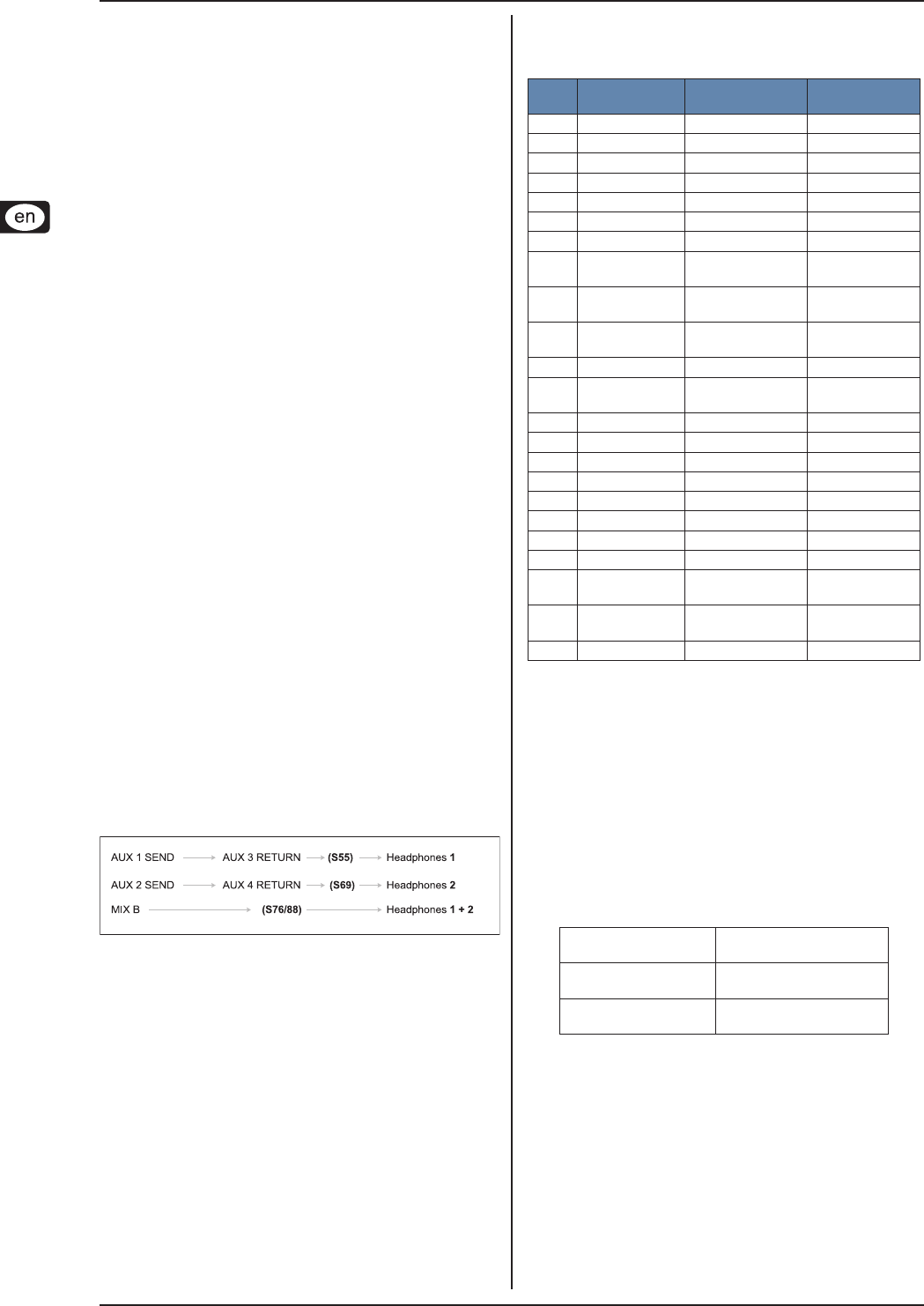
EURODESK SX4882
Professional 24-track studio20
Mixdown14.5
The situation here is no different from record, really, save that the
subgroups may now be routed directly to the main mix (L/R) bus
(S35 to 38) for easier mixing. Remember, you started off with the
tape returns coming up on A-channels 1 to 8, therefore there is
no need to “ip” them. You will probably (denitely) be running
lots of MIDI sequencer tracks live. Take care not to encourage
MIDI delays.
16-track recording with 2 samplers15.
Recording15.1
Subgroup outputs/tape sends 1 to 16 should be wired to the mul-
titrack record inputs 1 to 16. Sampler inputs should be connected
to subgroup outs 5, 6, 7 and 8 via custom-made Y-adaptors.
Lining up is as per the previous example (see section 14.3). When
choosing which outputs where to assign, you have to consider
that you have got maybe 16 tape and 16 or 20 sampler outputs
to accommodate onto 24 A-channels (and 24 B-channels)! We’d
suggest all audio tape tracks be returned on A-Channels, while
at least one stereo output from a sampler is also brought back
on a pair of A-channels for “ying in” (a sampler can pick up e.g.
chorus vocal and drop it into all choruses, or sample a particularly
nifty bit of anging on a drum loop etc.; then lay the effected loop
back to tape, without re-patching). Most other sampler outputs and
MIDI keyboards which need to be heard but not recorded can be
assigned to B-channels. The remaining six or so A-channels may
then be used for overdubs.
Headphones15.2
While auxless headphone monitoring (see section 14.2) is still an
option (and a pretty good one), a small general purpose studio
might require a more straightforward way of working using one or
two discrete headphone mixes. Here, it would be best to keep aux
sends 1 and 2 free for monitoring purposes until mixdown time.
Aux returns 3/4/5//6 can be routed directly to headphones 1 and/
or 2. A good idea would be to drive HP1 from a combination of aux
return 3 (S55) and MIX-B (S76), while HP2 picked up its signal
from aux return 4 (S69) and MIX-B (S88). Channel auxes 3 and 4
would be routed to A-channels. In this conguration a reasonable
degree of balancing between the MIX-B and aux 3/4 level into the
cans is possible by adjusting P55/68 (minus innity to +15 dB).
With the headphone conguration shown below, there is +
no easy way to get FX returns into the cans. Bring these
back on A or B channels instead, until mixdown time.
HeadphonesFig. 15.1:
Mixdown15.3
With 24 A-channels and up to 36 signicant tape and sampler
tracks to accommodate, some thought will need to be given to
mixdown assignments. Tracks which need little EQ and no ac-
cess to the main track reverbs/echoes on auxes 1 and 2 may
be parked on B-channels. Lead tracks and prominent rhythm/
melodic voices should be placed onto A-channels. Remember
that auxes 3/4/5/6 can be dedicated either to A or B-channels by
SOURCE switch S17.
Professional 24-track studio16.
Recording16.1
Chances are you’ll occasionally want to record more than eight
tracks at once, e.g. you’re recording a band playing together live.
The following example covers a rock band with drums, bass, two
guitars, percussionist, brass section, lead and backing vocals.
In the real world, you’ll hardly ever be taking all these artists at
once, but if you are:
Chan-
nels
Source Route Destination
1 Kick Direct out Track 2
2 Snare Direct out Track 3
3 Hi Hat Direct out Track 4
4 Tom 1 Subgroups 5 and 6 Tracks 5 and 6
5 Tom 2 Subgroups 5 and 6 Tracks 5 and 6
6 Tom 3 Subgroups 5 and 6 Tracks 5 and 6
7 Tom 4 Subgroups 5 and 6 Tracks 5 and 6
8
Cymbals (over-
heads) L
Direct out Track 7
9
Cymbals (over-
heads) R
Direct out Track 8
10
Bass
microphone
Subgroup 3 Track 1
11 Bass DI Subgroup 3 Track 1
12
Escaping
prisoners
Subgroup 4 Who knows?
13 Trumpet Subgroups 1 and 2 Tracks 9 and 10
14 Trombone Subgroups 1 and 2 Tracks 9 and 10
15 Sax Subgroups 1 and 2 Tracks 9 and 10
16 BVs 1 Subgroups 7 and 8 Tracks 11 and 12
17 BVs 2 Subgroups 7 and 8 Tracks 11 and 12
18 BVs 3 Subgroups 7 and 8 Tracks 11 and 12
19 Conga L Direct out Track 13
20 Conga R Direct out Track 14
21
Guitar 1
microphone
Direct out Track 15
22
Guitar 2
microphone
Direct out Track 16
23 Lead vocal Direct out Track 17
Channel assignmentTab. 16.1:
Tape Monitoring will be via MIX-B in tape return mode. Once tracks
are layed, they will be ipped onto the A-channels (1 to 17), and
overdubbing can commence via tracks 18 to 24. Also “bouncing”,
reducing several tracks onto one or a stereo pair, requires access
to the full routing matrix. This is available to the A-channels, but
not the B-channels.
Very tricky headphones16.2
In a multi-musician scenario you’ll probably want as many different
headphones mixes as you can muster. With the current channel/
group/track assignments it is possible to set up four independent,
or semi-independent, headphone feeds while still keeping back
auxes 3/4/5/6 for “wet” monitoring (see 16.3).
Subgroup 7 => aux re-
turn 3 => headphones 1
Subgroup 8 => aux return 4
=> headphones 2
Main mix (and)/or MIX-B
=> headphones 1
Main mix (and)/or MIX-B =>
headphones 2
Active switches: S55/
(S82, S77)/S76
Active switches: S69/(S82,
S89)/S88
See also g. 14.4 “Subgroup-driven auxless headphones mix”
and associated text.
In the above conguration HP1 and HP2 comprise a blend of the
main mix, MIX-B and an additional feed from a subgroup. The
subgroup feed can be used to select which channel(s) should be
boosted in the cans relative to the main mixes.
